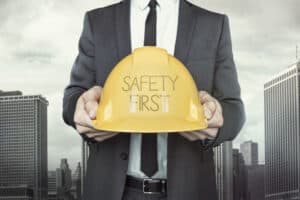
Promoting a Culture of Safety
The goal of any business owner should be to have a safe work environment that allows his or her employees to prosper and be in safe surroundings. The reality of the situation is that this noble goal can be forgotten as deadlines near and demands or pressures of the business grow. Instead of ignoring these goals, owners of businesses need to be mindful of the human element that makes their businesses successful. Emphasis should be placed on the following simple guidelines.
- Focus on workplace ergonomics. Employees that work in static positions are prone to severe or disabling injuries. This is especially true when people are performing repetitive activities or motions during their work experience. A review of all work activities should be made on a regular basis. This should also include the ability for employees to change positions or work duties frequently. This not only promotes a safer work environment but also certain intangibles such as cross-training, which can increase efficiency.
- Allow for regular work breaks. Too often it is easy for people to get into the mindset that work breaks diminish workplace efficiency. However, studies indicate the “law of diminishing returns” is present in workplaces where employees engage in repetitive work duties for extended periods. Allowing for work breaks keeps the workplace labor force motivated, improves morale, and can increase productivity in the long term.
- Allow only proper use of machinery or tools. During the course of work, machinery or tools are sometimes modified to assist employees in performing work activities. Many common “modifications” include the removal of guards or other safety equipment. These practices should be explicitly discouraged. Management should never turn a blind eye to these potentially dangerous, and in some cases, deadly modifications. Employees should also be reminded of how to safely operate equipment on a regular basis through education and in-service training opportunities.
- Promote a stress-free workplace environment. In a perfect world, there would be no stress in the workplace. Until that environment arrives, business owners and managers will be faced with challenges to promote a workplace that boosts morale and strives for greatness. Remember, you cannot make everyone happy, but certain intangible benefits can be offered as part of a package to make the workplace free of outside distractions.
Click Link to Access Free PDF Download
“4-Step Sequence For Effective Employee Screening, Hiring, & Placement”
Incorporate Safety into Workplace Training
The Occupational Safety and Health Administration (OSHA) is the agency within the U.S. Department of Labor charged with workplace safety issues. According to OSHA, the following components should be a part of any workplace-training program:
- Determine whether a worksite problem can be solved by training;
- Determine what training, if any, is needed;
- Identify goals and objectives for the training;
- Design learning activities;
- Conduct training;
- Determine the effectiveness of the training; and
- Revise the training program based on feedback from employees, supervisors, and others.
In following the OSHA model for workplace safety, it is important to take an additional step to ensure that a program is effective. The first step to take is to develop safety guidelines and guarantee it is understood by managers and employees. Once this is accomplished, informational and instructional programs should become incorporated into the initial training of new employees and ongoing education for the entire workforce. Companies should also remain compliant with federal and state standards, along with educating the workforce on industry best practices.
Once a program has been implemented, additional steps can also be taken to improve a program. According to OSHA, additional steps that improve programs are as follows:
- Determine if specialized training is needed;
- Identify the training needs within the workforce;
- Identify safety goals and objectives;
- Develop ongoing learning activities;
- Conduct a safety training program consistent with best practices;
- Evaluate the effectiveness of the program; and
- Improve your program.
Never be afraid to solicit input from the entire workforce on the program. It is also important to keep them engaged.
Lead By Example When It Comes to Safety
As a leader in the workplace, it is important for management and supervisors to lead by example when it comes to safety. In addition to following state and federal workplace safety rules, it is paramount that persons in a position of authority set the best example possible. By taking the time to do this, other employees will take note and do the same.
Take the uncommon approach to leadership. This is something that is earned by making other employees feel a part of the team when it comes to safety. Put those people first. Earn the right to be followed when it comes to safety.
- Create a safety committee and comprise the membership of employees from all areas of the company and skill levels. Make sure there is an environment where their input is welcomed and can be shared without fear of reprisal.
- Make managers a visible component of the workplace environment. The issue of safety should be emphasized in daily conversations and team meetings.
- Be proactive on fixing workplace safety issues. When a matter is corrected, make sure it is publicized for all employees.
Improving Safety Training in Your Company
Improving safety in the workplace also can start with the hiring process. Sometimes the “quick” hire” is not a smart decision. The results can lead to serious injury or death when hiring incompetent workers. As part of the screening process, it is important to ask potential employees about their skills and experiences. Situational questions can also be asked to determine if the prospective employee is aware of potential workplace hazards and has received prior training and instruction on how to deal with volatile or hazardous safety issues before an injury occurs.
Another part of having a safe workplace is improving existing courses and content. It is important for management and people administering courses to review materials and answer the following questions:
- Were any parts of the program content already known or covered in previous courses work?
- What aspects of the training are confusing or hard to understand?
- Is there anything missing from a program that should be covered?
- Are employees actually learning the material and applying it to their daily work tasks and responsibilities?
Employees can also be engaged on these questions when they evaluate a workplace safety program. Additional factors should be examined as part of this process:
- Workplace demographics and understanding what employee profiles are at a greater risk for accident or injury;
- Identify environmental issues that play a role in workplace accidents. This could include seasonal influences or other environmental factors such as heat and cold, or moisture on work surfaces; and
- Hazardous substances in the workplace and additional requirements for the handling of these substances or items.
Conclusions
Workplace safety is an important aspect of running a successful company. This is accomplished by placing an emphasis on workplace safety and creating an atmosphere that fosters buy-in from all levels of employees.

Contact: mstack@reduceyourworkerscomp.com.
Workers’ Comp Roundup Blog: https://blog.reduceyourworkerscomp.com/
©2020 Amaxx LLC. All rights reserved under International Copyright Law.
Do not use this information without independent verification. All state laws vary. You should consult with your insurance broker, attorney, or qualified professional.
















